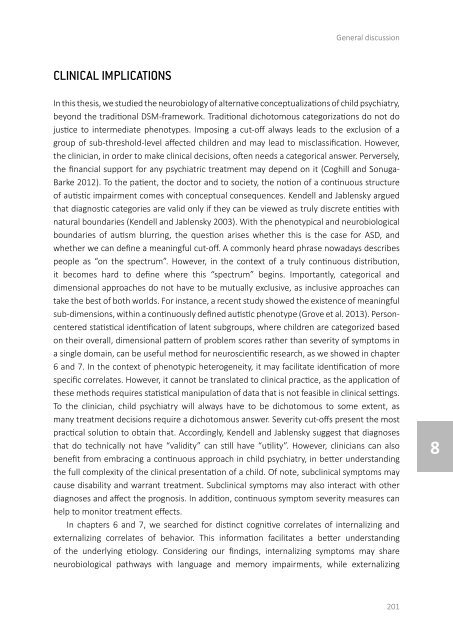On the Spectrum
2lm5UyR
2lm5UyR
You also want an ePaper? Increase the reach of your titles
YUMPU automatically turns print PDFs into web optimized ePapers that Google loves.
General discussion<br />
CLINICAL IMPLICATIONS<br />
In this <strong>the</strong>sis, we studied <strong>the</strong> neurobiology of alternative conceptualizations of child psychiatry,<br />
beyond <strong>the</strong> traditional DSM-framework. Traditional dichotomous categorizations do not do<br />
justice to intermediate phenotypes. Imposing a cut-off always leads to <strong>the</strong> exclusion of a<br />
group of sub-threshold-level affected children and may lead to misclassification. However,<br />
<strong>the</strong> clinician, in order to make clinical decisions, often needs a categorical answer. Perversely,<br />
<strong>the</strong> financial support for any psychiatric treatment may depend on it (Coghill and Sonuga-<br />
Barke 2012). To <strong>the</strong> patient, <strong>the</strong> doctor and to society, <strong>the</strong> notion of a continuous structure<br />
of autistic impairment comes with conceptual consequences. Kendell and Jablensky argued<br />
that diagnostic categories are valid only if <strong>the</strong>y can be viewed as truly discrete entities with<br />
natural boundaries (Kendell and Jablensky 2003). With <strong>the</strong> phenotypical and neurobiological<br />
boundaries of autism blurring, <strong>the</strong> question arises whe<strong>the</strong>r this is <strong>the</strong> case for ASD, and<br />
whe<strong>the</strong>r we can define a meaningful cut-off. A commonly heard phrase nowadays describes<br />
people as “on <strong>the</strong> spectrum”. However, in <strong>the</strong> context of a truly continuous distribution,<br />
it becomes hard to define where this “spectrum” begins. Importantly, categorical and<br />
dimensional approaches do not have to be mutually exclusive, as inclusive approaches can<br />
take <strong>the</strong> best of both worlds. For instance, a recent study showed <strong>the</strong> existence of meaningful<br />
sub-dimensions, within a continuously defined autistic phenotype (Grove et al. 2013). Personcentered<br />
statistical identification of latent subgroups, where children are categorized based<br />
on <strong>the</strong>ir overall, dimensional pattern of problem scores ra<strong>the</strong>r than severity of symptoms in<br />
a single domain, can be useful method for neuroscientific research, as we showed in chapter<br />
6 and 7. In <strong>the</strong> context of phenotypic heterogeneity, it may facilitate identification of more<br />
specific correlates. However, it cannot be translated to clinical practice, as <strong>the</strong> application of<br />
<strong>the</strong>se methods requires statistical manipulation of data that is not feasible in clinical settings.<br />
To <strong>the</strong> clinician, child psychiatry will always have to be dichotomous to some extent, as<br />
many treatment decisions require a dichotomous answer. Severity cut-offs present <strong>the</strong> most<br />
practical solution to obtain that. Accordingly, Kendell and Jablensky suggest that diagnoses<br />
that do technically not have “validity” can still have “utility”. However, clinicians can also<br />
benefit from embracing a continuous approach in child psychiatry, in better understanding<br />
<strong>the</strong> full complexity of <strong>the</strong> clinical presentation of a child. Of note, subclinical symptoms may<br />
cause disability and warrant treatment. Subclinical symptoms may also interact with o<strong>the</strong>r<br />
diagnoses and affect <strong>the</strong> prognosis. In addition, continuous symptom severity measures can<br />
help to monitor treatment effects.<br />
In chapters 6 and 7, we searched for distinct cognitive correlates of internalizing and<br />
externalizing correlates of behavior. This information facilitates a better understanding<br />
of <strong>the</strong> underlying etiology. Considering our findings, internalizing symptoms may share<br />
neurobiological pathways with language and memory impairments, while externalizing<br />
8<br />
201


